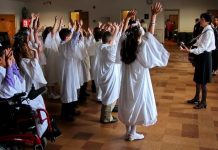
A helpful overview for reading the Bible
CATHRYN TORGERSON
Reading the Bible is a wonderful adventure! But sometimes it can leave us feeling a little lost, confused, or frustrated. To assist you on your journey, we have some guidelines to help orient you to engaging God’s word.
The big picture
To start, we want to consider what the Bible is, or perhaps more practically, what it is not. While the Bible tells the story of salvation history, it is not one continuous plot. Nor is it a history book in the sense we think of history today. While it narrates events of creation and nature, it also is not a scientific text.
The Bible is a collection, or library, of 73 books that have different authors. These books were written at different times for different purposes and use multiple literary styles. (See the infographic: CAT.Bible_infographic)
As a whole, this collection reveals God’s plan for us. This makes the Bible primarily a theology book because it teaches us about God.
The Bible is divided into two sections: the Old Testament, comprised of Jewish writings and written mostly in Hebrew, and the New Testament, comprised of Christian writings and written in Greek.
Although the two testaments come from different languages and eras, they work together to reveal the continuous story of God’s journey with his people. The Old Testament often points to events and people that appear in the New Testament. The New Testament better explains what happened in the Old Testament.
The Bible we know today was compiled in stages. Initially, the ancient Jews shared oral traditions. These were eventually written down, collected, and came to be considered sacred texts.
Similarly, the New Testament grew out of documents used by the early Church communities. God guided the early Christian Church to define the books of the Bible in 382 A.D. Since then, Catholics have been studying the Old and New Testaments we have today as the inspired word of God.
Overview of the Old Testament
One common way of reading the Bible is to begin at the beginning with the story of creation in Genesis. This leads to the familiar narratives of Adam and Eve, Noah, and Joseph, who ends up in Egypt. From there, Exodus leads us through the plagues and on
the wilderness journey with Moses.
Then we hit Leviticus, where it is easy to feel stuck in the mud with pages of laws. Even if we manage to survive that section, we can get bogged down in the following narratives of kings and symbolic prophecies. To avoid confusion, it is helpful to understand the grand scope of the Old Testament.
The Old Testament begins with narratives of how God created the world. Then it relates how God formed a nation to have a special place in that world. This nation would honor him through a covenantal relationship.
Books focusing on this narrative are called the Historical Books (which include the Pentateuch) and read like history books. The Bible, however, is not like a modern history book. It was not based on historic documents, diaries, or newspaper articles. It was
written to explain God’s relationship with his people. Thus it views all events of history through the lens of revealing who God is and what he desires from those he has called to relationship.
Often the people of God do not follow him well, and this is where God’s word can be challenging. It seems that God is punishing the people for not being good enough. It helps to remember that God wants good for his people, but there are negative consequences for not following his commands.
The books of the prophets contain the preaching of men sent to call people back to their covenantal relationship with God.
While the prophets preach the negative effects of turning from God in the present, they always include some form of hope in the future for those who do return. These restoration prophecies are fulfilled in the New Testament or will happen during the end times.
The prophets often write in a poetic style that utilizes metaphor and imagery to explain spiritual and material realities. The Hebrew style of poetry is different in style from the poetry of other cultures, but it similarly evokes emotion and imagination.
Poetry that is sung is found in the Book of Psalms. Like our hymnals today, this collection of songs covers different personal and communal events, emotional experiences, and praise of God.
Finally, the books in Wisdom Literature look at what it means to live through good and hard times as followers of God. These books seek the meaning of life, remind us of God’s role in society, and provide pithy advice for how to stay on God’s path from day to day.
What is revealed throughout the Old Testament is that God wants us to be in relationship with him, but we are not always very good at it! Every book of the Old Testament reminds us how much we need God’s help. Even the many laws God gave the Jewish people were not enough, so he promised to send a person, a messiah to care for and save us. Those
promises lead us into the New Testament, where we meet that person: Jesus.
Overview of the New Testament
The New Testament opens with the four Gospels, each an account of how Jesus has come to restore our relationship with God. We may think of these as biographies, but ancient biographies are not quite the same as modern biographies.
The purpose of biography in New Testament times was to extol the virtues of a great figure so others would be inspired to follow him. Thus we hear highlights of a life rather than the chronological details we might expect. It is also why each Gospel is different: Each author, to inspire his audience, focused on different aspects of Jesus’ character and mission.
After the Gospels comes the Acts of the Apostles. It is also written by Luke, and shows how Jesus’ mission to bring salvation continued in the early Church under the guidance of the Holy Spirit.
From there we move into the letters written by early Church leaders to various communities and people. The letters exhort Christians to live faithfully in a pagan world; teach theology about who Jesus, the Father, and the Holy Spirit are; and warn against
false teaching.
The letters are categorized into two groups: those written to specific communities and people, and those that are “universal” (in Greek, “catholic”).
The whole Bible closes with the Book of Revelation, often considered one of the most mysterious books in the Bible! It is a symbolic prophecy about what is happening in the world today and what will happen at the end of time. We learn in Revelation
that God’s goal for us is a return to paradise, where we will enjoy his presence as Adam and Eve did in the garden at the start of Genesis.
Some Practical Advice
Now that you have the big picture in mind, where should you start actually reading the Bible?
■ In the Old Testament, if you want something familiar, Genesis and Exodus will remind you of Bible stories from childhood.
■ The Psalms are rich in expression and emotion, providing new ways to think about prayer.
■ Reading short prophets like Micah or Habakkuk allows you to dip your toe in the prophetic water before tackling popular long prophets like Isaiah or Jeremiah.
■ Ruth, Tobit, and Esther reveal good people in hard circumstances and how God helps them.
■ The Book of Wisdom points us to several aspects of Christian theology while commemorating God’s work in Jewish history.
■ Proverbs can be read one chapter per day over the course of a month to help you live daily for God.
■ In the New Testament, Mark’s Gospel is an excellent starting point. It is the shortest Gospel and can be read in less than one hour!
■ Paul’s concise letter to the Philippians is considered one of his most beautiful, and it reveals Paul’s love for Jesus.
■ Acts is an exciting adventure that depicts many aspects of the early Church still visible today.
■ The letters of James and 1 Peter provide practical advice, and 1 John reminds us of the value of love.
■ The best advice for reading the Bible is simply to start. Before you begin reading, ask God to show you what he wants you to know. This is his living word, given to you personally. He has something there for you: Just accept the adventure to discover it.
Cathryn Torgerson, MA, teaches Scripture to adults as the Curriculum Director and an
Instructor for the Catholic Biblical School of Michigan.
This article was originally published in Catechist magazine, September 2018
PHOTO: EKAPHON MANEECHOT/SHUTTERSTOCK




